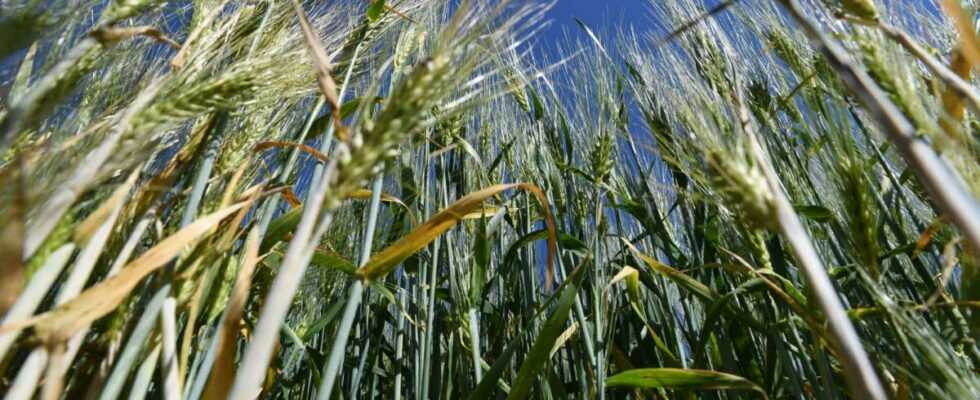The prices of agricultural products have resumed the bite in their teeth this week, particularly wheat and corn, close to their all-time highs, while the conflict in Ukraine is bogged down and world wheat stocks are announced to be falling.
“We have markets that have returned, all products, to levels close to the highest known. The situation in Ukraine is not improving, and this is all the more important as we approach crucial periods for spring sowing,” warns Gautier le Molgat, an Agritel analyst.
Rare positive point: the big cold snap in France caused almost no damage to cereals.
The war in Ukraine sows doubt
Before the war, Ukraine, once dubbed “the breadbasket of Europe”, exported 12% of wheat, 15% of corn and 50% of sunflower oil worldwide.
“The stalemate in the conflict is now pushing back Ukraine’s ability to return to the market, extending the time when the ports will be able to export,” warns Edward de Saint-Denis, broker at Plantureux et associés. Ukrainian export capacity is stagnating around 10%, only by road and rail, while the neighboring Black Sea ports (Bulgaria, Romania) are congested.
Will the Ukrainian harvests be possible?
“It is clear that they have planted their wheat, but will they be able to harvest it and then export it? This is the question” that torments the markets and drives up prices, says Jason Roose, of the American broker US Commodities.
Even the sowing conditions remain difficult, according to Edward de Saint-Denis: “from what we see with our customers there, a big problem comes from the (lack of) fuel oil to supply the machines and allow sowing “.
Cereal prices impacted by oil prices
“This market continues to accumulate risk premiums every day: inflation premium, war premium, climate premium,” summarizes Jason Roose, of the American broker US Commodities. “The agriculture sector is capturing the attention of the whole world,” he adds as grain prices are spurred on by those of oil.
The rise in crude oil in particular leads to that of oilseeds, used in the production of diesel (rapeseed, soy) or ethanol (corn) in the United States.
Cultures in the United States supported by China
In the United States, winter wheat crop conditions remain poor and maize planting is getting off to a slow start, according to a report from the Department of Agriculture (USDA). The cold, wet weather in the midwest, dry in the southern Great Plains, “isn’t ideal for the start of planting, not what growers would like to see,” which was still supporting prices, Jason Roose said.
Corn, whose price in Chicago is at its highest for more than 10 years, has also benefited from mega-purchases from Beijing in recent weeks. “China has been a very large buyer of US corn for the past two weeks because it needs animal feed and Ukraine cannot currently offer any supplies,” said Jack Scoville of Price Futures Group. China has ordered two shipments of one million tons of maize each.
But US Commodities’ Jason Roose wonders if Beijing “is going to have the buying power to order more with prices at this level.”
Soy close to all-time highs
Rising soybean prices, which are also sailing at all-time highs, were muted for a few sessions due to “concerns about Chinese demand due to Covid-19-related lockdowns there,” said Jack Scoville. .
Especially since the supply available for export from South America “remains limited”, according to the expert.
The sunflower in France is getting ready
According to a press release from the Confédération paysanne, “technical and professional organizations are currently pushing to increase the areas to be sown by proposing to modify the planned rotations, in order to increase the national volume of production”.
French agriculture is therefore preparing to try to cope without Ukraine. But the Confédération paysanne warns about the use of varieties made tolerant to herbicides (VrTH), “of GMO nature”.
Wheat, a tense sector
In the Mediterranean basin, the demand for wheat remained strong “with the drought in the Maghreb, in particular in Morocco, where there is talk of a 50% drop in expected production”, underlines Edward de Saint-Denis.
“In general, the operators are very tense, and the industry is forced to face a galloping inflation of raw materials and its production costs”, concludes the broker of Busty and Associates.
What are the prices ?
On Euronext, around 1 p.m. GMT on Wednesday, soft wheat was selling at 398 euros per tonne for delivery in May, and corn at 331 euros per tonne for June. Rapeseed was at 988.50 euros per tonne for May.
On the Chicago Stock Exchange, shortly before the opening, the price of wheat of the SRW variety reached 10.9650 dollars a bushel and corn 7.7225 dollars for deliveries in May. Soybeans were trading at $16.6925.
